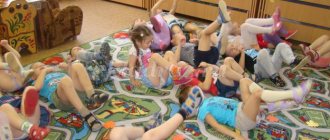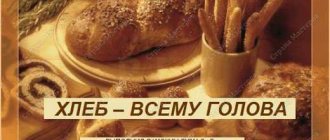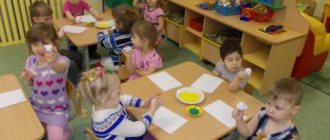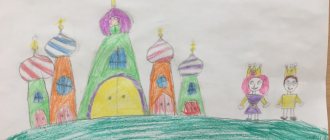Drawing with salt and glue
This is a classic technique. For the lesson you need to prepare templates. Draw or print out outline images. The outlines must be clear so that children can see them clearly. Try to maintain the composition so that the sheet of paper is evenly filled with the image and there are no empty areas.
Below is a step-by-step master class on how to paint with salt:
- Take PVA and draw the tip of the bottle neck along the contours of the design. Squeeze out the glue, but not too much. Along the contour there should be an even and narrow adhesive strip.
- Cover the leaf with salt. Don’t skimp, the salt grains should completely cover the lines coated with glue.
- When the glue has set a little with the salt, shake off what didn't stick.
- Leave the painting to dry. It will take at least an hour to dry, sometimes even longer if the salt lines are quite thick.
- When the template is dry, start drawing. Take a brush, dip it in water, pick up paint, then carefully apply it to the salt line. The paint will flow beautifully over it.
It is preferable to paint with salt and watercolors. Gouache can also be used, but it is thicker and forms a more saturated color of the drawing. If you want more airiness, characteristic of watercolor, you will have to greatly dilute the gouache with water.
Watercolor should be diluted thinly. Firstly, it will make the drawing lighter, more pastel. Secondly, thickly diluted paint is poorly absorbed into the salt circuit.
Instead of a brush, you can use a pipette and fill it with paint diluted with water of the desired concentration. But this type of work is more suitable for older preschoolers, while it will be difficult for children to learn how to work accurately with a pipette.
You can draw with one color or several. In a multi-color drawing, the colors will softly and intricately flow into each other. The salt drawing in itself is interesting and voluminous, but if desired, it can be supplemented with elements made in another visual technique, for example, in the form of appliqué or splashes.
On the topic: methodological developments, presentations and notes
collective work of children of group No. 91 of senior preschool age “Our favorite snowman Tosha.”
Summary of an open physical education lesson for the senior preschool group of a kindergarten on the topic: “Birds.”
Goal: to introduce children to the rules for pedestrians and passengers. Objectives: 1. Reinforce with children the concepts of “driver” and “pedestrian.”2. Develop children's horizons and logical thinking.
Musical lounge for May 9 “With a song until Victory.” Notes with a presentation for children of the senior preparatory group of kindergarten.
Formation of moral and patriotic feelings in children through systematization of knowledge about the Constitution of the Russian Federation.
Many safety rules arose in ancient times, when people tried to protect themselves from wild animals and natural phenomena. Over time, human living conditions have changed and become different.
A lesson to familiarize children with the work of kindergarten staff.
Source
Preview:
Abstract of educational activities in the senior group (speech therapy)
Topic: “My favorite kindergarten” (collage)
Educator: Naumova E. A.
- develop creativity, fantasy, imagination;
- help the child demonstrate his artistic abilities in various types of visual activities.
- develop an aesthetic perception of the world, nature, and artistic creativity of children.
Develop the imagination of children, supporting the manifestation of their fantasies, courage in presenting their own ideas;
- involve children in working with a variety of materials;
— learn to create collective works.
Materials and equipment for the lesson:
- a large sheet of Whatman paper with a ready-made background (an image of a child holding a huge planet in his hands);
- clippings of pictures from magazines;
- felt-tip pens, pencils, wax crayons, pastels and other materials for drawing (children’s choice);
- scissors, glue, napkins.
- making a background for group work together with the children;
- a preliminary drawing lesson, in which children learned to depict people in motion, starting with a schematic representation of a person;
The teacher conducts a conversation with the children about the kindergarten, their group, and what they like (don’t like) about the kindergarten. During the conversation, the teacher invites the children to remember poems about kindergarten and the senior group (which the children learned earlier).
Children are then asked to portray themselves doing something they love (playing, drawing, dancing, watching, etc.). children draw, starting with a schematic image of a person, then drawing a face, hairstyle, clothes, etc.
During the work, the teacher helps the children, talks, and asks about their interests.
You can rest a bit during class
- do finger exercises:
The girls and boys in our group are friends;
You and I will make friends with little fingers:
Children stand with an adult in a circle and join hands. “Let's imagine that we are one. Listen to our breathing. Let's breathe in and out together, in and out. Very good. Let's listen to how our heart beats, knock - we take a step forward, knock - a step back. And again, knock – a step forward, knock – a step back.”
Exercise “We are good.”
When the drawings are ready, the teacher suggests cutting out the images, supplementing them with details cut out from various magazines and making a collage on our pre-made background. Next, the children and their teacher look at the collage and share their impressions. The teacher thanks the children for their interesting work and praises them. In the evening, the children show their completed work to their parents. Next, the collage decorates the group or locker room.
On the topic: methodological developments, presentations and notes
Objectives of the lesson: learn to draw a bear along the contour with a poke; instill interest in drawing and foster cognitive activity. Learn to find similarities with a toy and enjoy the result.
Non-traditional techniques: colored scratch paper, wax crayons + watercolor, watercolor crayons. Purpose: to form an aesthetic attitude towards fairy-tale characters; learn to display the features of images in a drawing.
GCD for drawing in the second junior group based on the nursery rhyme “Cucumber, Cucumber.” GCD in the middle drawing group based on the nursery rhyme “Magpie, Magpie” Plan – summary of the GCD in the senior drawing group on the so-called.
Summary of a lesson in a senior group on drawing on the topic: “Spring drops.”
Compiled by: teacher 1st quarter. Denisova I.S. .
Lesson notes on artistic development.
Goal: teach children to draw a church with colored pencils.
Source






